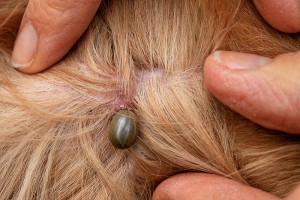 Spring has sprung and so have ticks!
Spring has sprung and so have ticks!
In Australia, adult ticks are in their highest numbers during the warmer months of August to February. These little nasties can make your pets very sick and even cause death. As a pet owner you need to be aware of ticks and do your best to prevent your pet from falling victim to them. It is important to know how to check your pets for ticks and how to remove them if you do find one on your pet. If you live in a tick area it is very important to be diligent in tick prevention as well as checking your pets for ticks and knowing the signs and symptoms that may be seen if your pet does have a tick.
Checking your pets for ticks is something that should be done daily during tick season, especially if you live in a tick area. Ticks start out very tiny, the size of a pin head, so they are almost impossible to see until they have attached and started to feed on the animals blood and then they enlarge. Ticks can be very hard to find, particularly on thick coated or long haired pets. Sometimes ticks have already fed and fallen off before you find them, this will usually leave a “tick crater” on the skin which looks a small indentation where the tick was attached and is often raised around the edges.
Here are a few tips on how to effectively check your pets for ticks;
* Run your fingers through the animals coat feeling the skin with your fingertips. Ticks and tick craters can be felt as lumps on the skin.
* Start at the pets nose looking closely at the face, ears (inside and out) and the lips (checking the underside of the lips)
* Then work slowly down the neck, carefully checking any skin folds.
* Remove any collars and thoroughly check where the collars sits.
* Move down the the neck and down the shoulder of one leg, checking the paw, toes and between the toes and then move back up and check the other front leg.
* Continue checking the animals back and sides and then check each hind leg and paw one by one.
* Be sure to check the entire length of the tail, particularly under the tail and around the anus.
* Then thoroughly check their chest, stomach and under their armpits (front and back).
* Do the search slowly, methodically and as thoroughly as possible.
* Pay particularly close attention to areas where ticks often hide like the paws, between the toes, under the armpits, around the anus, under collars, in skin folds, under the lips or under and in the ears.
If you do happen to find a tick you need to remove it quickly and safely, to prevent any further toxins being injected into the pet’s bloodstream. This can sometimes be difficult depending on the position and size of the tick and how cooperative the pet is when you try to remove it. It is most important that when you remove a tick you ensure that the entire tick, head included, is removed.
Here are some tips on how to remove a tick from your pet;
* Most importantly you must avoid squeezing the body of the tick as this can cause them to release more toxins into the pet.
* Do not put any chemicals on the tick as they may be toxic to your pet or even aggravate the tick causing it to release more toxins.
* The best way to remove a tick is to use a Tick Remover like a Tick Twister or The Tick Key. These work like a hook that you slide under the tick, then pull back and then tick can be safely removed head and all.
* If you don’t have a Tick Remover you can use tweezers. Be careful not to squeeze the tick’s body and get the tweezers close to the skin where the head is embedded and pull the tick away from the skin.
* Wrap the tick in a tissue and keep it in a container in case your veterinarian wants to see it.
* Continue to check your pet even if you find a tick as they can often have more than one.
* If you do not feel confident in a removing the tick you should contact your veterinarian immediately and they will be able to assist you.
Even if you pet appears to be fine and healthy I suggest contacting your vet for advice after removing a tick. Be sure to keep a close eye on your pet over the following days and try to keep them a bit quieter and avoid extreme stress for a few days. If your pet becomes unwell or starts to show any signs of tick paralysis or poisoning contact your veterinarian immediately, do not wait overnight. Even though the tick has been removed the toxins may already be in the bloodstream and can make the animal very sick and even cause death, very quickly.
For further information on ticks, tick paralysis, signs and symptoms of ticks on pets and preventative measures please visit my previous blog “Tick Paralysis” or speak with your veterinarian.
Until next time,
Bec
